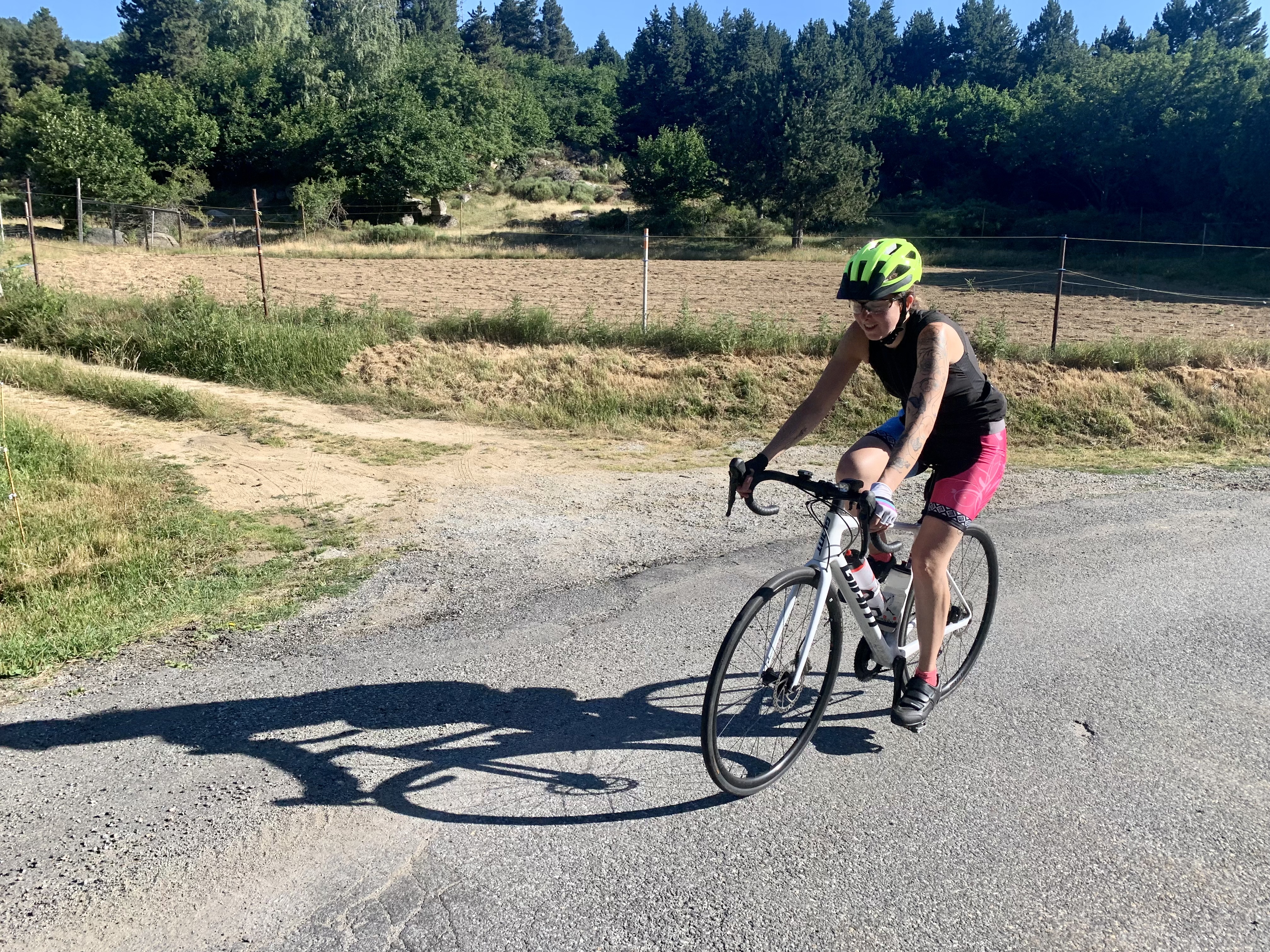Is cycling uphill different to cycling on the flat?

Some people are better at cycling uphills than others and some are better at cycling on the flat. Why is this? I thought it would be interesting to explore the differences between cycling uphill and on the flat and give some thoughts on how you can get better at cycling uphills.
Cycling uphill is different to cycling on the flat because the force of gravity changes the way the bike behaves. Force on the pedals varies during each pedal revolution, so you speed up and slow down slightly. When you are cycling uphill you have the additional force of gravity and less momentum, so you slow down quicker, which exaggerates the slight changes in speed and force on the pedals with each pedal revolution, making riding uphills different.
With practice, you can get better at cycling uphills and as you become more efficient you will get faster for the same amount of effort.
Your muscles work similarly uphill and on the flat
There is very little difference in the muscles you use when cycling uphill and on the flat.
There is no change in the relative position of your saddle and your pedals so if you are sitting down while pedalling there is no change in the angles at your joints and therefore no change in the way you need to apply force.
If you are riding out of the saddle you will adjust your position to put your weight over the pedals and therefore allow for the gradient automatically, pushing down on the pedals in the same way irrespective of the gradient.
Of course, if the hill is very steep and technical you may need to adjust your position to keep grip on your back wheel and stop your front wheel lifting, which would obviously require some changes and additional effort but this is an unusual circumstance that requires particular riding skills.
The gradient doesn’t make a big difference to the forces of gravity on your pedalling
It is easy to think that climbing will change the way you apply forces on the pedals due to gravity but the angles are not very big.
A steep road climb of 10% is an angle of less than 6 degrees and even a very steep, 25% gradient where you may be struggling for grip in the wet is only 14.5 degrees.
Because we don’t change our position while seated and can easily accommodate these angles when out of the saddle, the way we use our muscles to push on the pedals doesn’t change a lot.
Gravity and speed change the way the bike moves
For a given power, you go faster on the flat than when you are riding uphills. This means that you have more momentum, which means that you don’t slow down as much when you stop pedalling.
We all know that if we stop pedalling on an uphill we will quickly come to a stop, but if we are whizzing along on a flat road we won’t slow down much if we stop pedalling.
You may say that this is because there is more force slowing us down when we are going uphill but that isn’t the case because Newton taught us that for every action there is an equal and opposite reaction. This means that if you are riding at a constant speed with a power of say 200 Watts, the force you are riding against must be the same.
The difference when you are riding on the flat is mostly due to wind resistance, with some due to resistance between the tyres and the surface you are riding on, known as rolling resistance. When you are riding uphill you have gravity as well, so you can’t go as fast for the same power.
The steeper the hill, the more force due to gravity and the slower you go and what this means is that you have less momentum. Momentum is equal to your mass multiplied by your velocity. So slower means less momentum and therefore less energy to keep you going and you slow down quicker.
The fact that wind resistance doesn’t vary in the same way as gravity, relative to speed, makes this even more emphatic but we don’t need to go into that here.
The bike moves differently as you pedal uphill
When you pedal, the force on the pedals varies throughout each revolution of the pedals. Roughly speaking, it is highest when the cranks are horizontal and lowest when the cranks are vertical.
Because power is equal to force multiplied by velocity, you can imagine that the bike slows down and speeds up slightly as the force on the pedals varies throughout each pedal revolution. This is hardly noticeable when you are riding but it is significant to how efficiently you ride and of course, the smoother you pedal, the less variation in speed.
Because you have less momentum when riding uphills, the variation in speeds is greater and therefore you have to accelerate the bike slightly more to maintain speed uphill with the same pedalling action.
For this reason, you need to practice cycling uphills to get better at it and as your uphill riding skills improve, you will be more efficient when you ride uphills.
The good thing is that you don’t need big hills to improve this because you are trying to improve a skill and you can train your physiological fitness by training on the flat or indoors on a trainer if you prefer.
You can get fit for riding uphills by training on the flat
With respect to your riding fitness, and because there isn’t a big difference to which muscles you use on the flat and uphill, not living near big hills isn’t as big a problem as you might at first think.
You can improve your cardiovascular system in the usual way and your fitness will be applicable to hills and flat in a similar way.
What you need to do, to get better at hills is to practice the skills of riding uphills so your mind and body know how to do it and become more efficient on climbs.
You can also simulate hills by riding indoors on a static bike with high resistance because this will mean you have less momentum, effectively simulating riding slower and therefore being quite similar to riding uphills. This could be a good way to practice long climbs if you don’t have big hills available nearby.
You need to practice riding uphills to get better at riding uphills
As with most things, the more you do the better you will be… as long as you don’t do too much. You will need to decide how much priority to apply to improving your climbing skills and then schedule an appropriate amount of time to it.
The good thing is that because it is practice, you can use almost any hill and even if it is short, you can just do it a lot of times. You can also make big gains by just doing easy rides on hills so including regular hill climbs in your recovery rides will make a difference.
Hills are great places to do harder efforts though, so if you have an appropriate hill you can do some of your interval work on climbs and build both your skills and your fitness.
Obviously, if you think you will need to sprint uphills for some reason, you will need to do appropriate sprint training on climbs, because in this case you are training your neuromuscular power (your motor skills) and therefore you need to be as specific as possible, although sprinting on a static bike with high resistance may be similar.
If you really can’t find any hills to practice on, remember you can get a similar, but not the same, effect riding indoors on a static bike with high resistance because this will mean you have less momentum, effectively simulating riding slower and therefore being quite similar to riding uphills. This could be a good way to practice long climbs if you don’t have big hills available nearby.
Related questions
Is weight important to how fast I can ride uphills? Weight is important to how fast you can ride uphills but it may not be as significant as you think. The force due to gravity is directly proportional to weight, so if you are going slowly enough for wind resistance to be insignificant, your speed will be proportional to weight. However, it is the combined weight of you, your bike and any luggage you are carrying that is important, so if you weigh 70kg, your bike weighs 10kg and you have 1.5 litres of water (1.5kg), you have a total weight of 81.5kg, having a bike that is 1kg lighter (a huge amount) will only be saving you just over 1% overall, so not a big difference. If you are carrying kit, this is even less significant.
Does the bike make a difference to how fast I can ride uphills? Better bikes are better, there is no getting away from it and more expensive bikes tend to be better bikes. So, you can climb faster on better bikes. However, if you are on a long ride, you need to consider comfort and a bike that allows you to generate more power may not be one that you are comfortable riding for hours at a time. In this case, you could end up being faster on a more comfortable bike.
We hope you enjoyed this article and found it helpful.
Tags:
cycling, Cycling Training, Heart Rate Monitor, Cycle Training, Bikepacking, Nutrition, Coaching, Mountain BikingJune 11, 2020

Comments